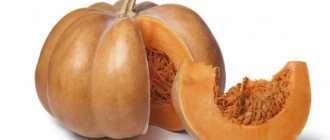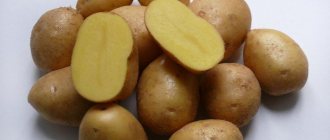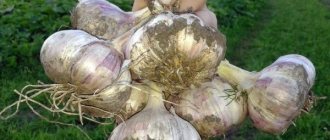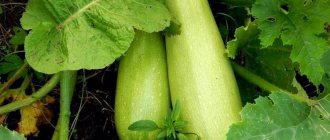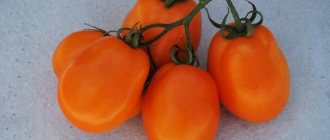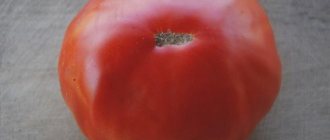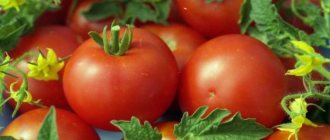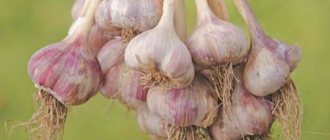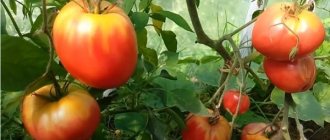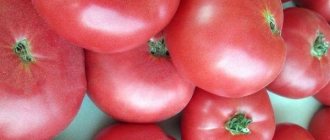Description of varieties
Garlic seeds were first bred in Holland and are now distributed throughout the world. Like any variety, Messidor has its own history and external characteristics.
History of selection of Dutch crops
Holland deservedly ranks second among the top three leaders in the global market for sales of planting materials due to the high quality of seeds. Over the years, billions have been spent on Dutch selective research, and scientists have been obtaining new species that are distinguished by their special productivity, strong immunity and long shelf life.
Despite its stable position, the Netherlands continues to develop the selective institute and regularly delights gardeners around the world with new varieties of plants and vegetables.
Appearance
Dutch garlic Messidor is distinguished by a large, round white head and long, dark green leaves, 12 on each vegetable. The width of one garlic arrow is up to 2.5 centimeters, length – up to 70 centimeters. The structure of the bulbous head is simple.
Clove size and weight of bulbous vegetable
Each garlic head contains 8-14 cloves, which have a bitter taste and a distinct garlicky odor. They contain sugar (23.3%) and ascorbic acid (9 milligrams). The total weight of the onion head is from 100 to 160 grams, which allows you to collect more than 20 tons from one hectare.
How does it grow and when does it ripen?
Messidor is a winter variety, which means it grows in winter. It is distinguished by early ripeness and, unlike other winter species, in good weather it germinates already in June, in cloudy and rainy weather - at the beginning of August, in dry weather - at the end of July. Signs of garlic ripeness:
- if the arrows are cut, then the main indicator will be the leaves: the lower ones will dry out and the upper ones will turn yellow;
- if the arrows are left, then the shell of the air bulbs should burst;
- it is necessary to dig up the ground near some vegetables - the scales of the head should be dry and strong; If it breaks easily, it means the garlic is overripe.
Garlic variety Parador ultra early
This super ultra early variety of winter garlic is called highly productive due to its excellent properties, which are described below.
Absolutely all types of soil are suitable for garlic of the Parador ultra-early variety; its planting can begin in the second ten days of October and last until the first ten days of November. So, like for some of its brothers, the optimal air temperature for it is considered to be about +5 * C. And also it should not be replanted in the same place earlier than after 4-5 years.
the head of such a root crop grows quite large and has a round, but slightly flattened shape, which reaches about 6 cm in diameter. The scales that cover the bulb are purple-white in color, they seem to be painted with stripes alternating these two colors. Each head of garlic can form about 10-12 cloves, which in turn are also covered with brown-white scales.
This ultra-early garlic of the Parador variety will be a real boon for those gardeners who cannot visit the plant very often in order to break out the arrows in time, because this variety is very resistant to bolting. It should also be noted that this variety of garlic is characterized by high resistance to viral and fungal diseases. And what is also very important is its ability to be stored for a long time.
Due to its good taste, as well as excellent commercial properties, this plant is very popular among many gardeners.
Comparative characteristics
Dutch Messidor has distinctive characteristics that give it advantages over other varieties.
See also
Description and characteristics of garlic variety Komsomolets, planting and care
Read
Susceptibility to insects and diseases
Messidor is distinguished by high resistance to the following diseases:
- bacteriosis;
- various types of mold;
- white rot.
Low temperature resistance
Garlic is frost-resistant, and in fields where there is no snow, it can withstand temperatures down to minus 15 °C. In places where snow falls, it is also resistant to lower temperatures - down to -21 ° C.
Advantages of varieties
Both Messidor and Germidor take root in different climate conditions, growing on loam, sandy, soddy-podzolic soils, and chernozem. Garlic is grown both in arid steppes and in regions with high humidity. The advantages of Dutch varieties include resistance:
- to bacteriosis;
- black and green mold;
- white rot.
Planted crops can withstand frosts of up to 15 degrees in fields where there is no snow and produce an excellent harvest. The bulbs are perfectly stored until January and do not lose their presentation. The best cloves are selected for seeds; there should be at least 8 of them in one head.
Necessary conditions for growing crops
Despite the unpretentiousness of garlic, gardeners should still follow simple growing rules to obtain a healthy and large harvest.
Illumination
Messidor loves light, so you should choose areas where the sun falls all day.
Humidity
When planting garlic, it is necessary to choose soil that is not flooded when snow melts or rains, as well as one where there is no accumulation of groundwater, since Messidor is not grown in wetlands.
Temperature
Despite its frost resistance, garlic should be planted at least a month before the onset of persistent cold weather, so that the root system has time to take root, although the stems and leaves have not yet had time to germinate.
Required soil composition
To replenish the necessary components in the soil, before planting you need to dig up, disinfect the soil with a solution (1 gram of boric acid, potassium permanganate and copper sulfate per 1 liter of water) and add fertilizers (humus - 5 kilograms, 30 grams of superphosphate and 25 grams of potassium salt ).
It is better to choose land in which cucumbers, new potatoes, peppers, tomatoes, pumpkins or eggplants were grown. Planting in soil where late potatoes, carrots, turnips or radishes grew is not recommended. Also, Messidor should not be planted in the same place to avoid fungus or pests. If the soil is clayey or acidic, you need to add sand to it.
Features of agricultural technology
The planting material needs to be changed every 4 years, otherwise the crop will begin to degenerate, the heads will become small, and the yield will decrease. You need to select a place for the garden bed where the sun shines all day and there is no shadow. Garlic does not tolerate swampy soil, where underground and melt water accumulates.
It is not recommended to plant a varietal plant in an area where bulbous crops, carrots, potatoes, and radishes grew last season. You can’t grow garlic in one place, it will start to hurt and pick up a fungus.
After digging up the soil, which must be done in the fall, the soil is treated with a mixture that is prepared by mixing a gram of boric acid, copper sulfate and potassium permanganate in a liter of water. Some summer residents temporarily cover the garden bed with polyethylene.
Garlic cloves are sorted before planting, diseased seeds are put aside, and healthy ones are soaked in a pink solution of potassium permanganate. The soil is fertilized with humus or dry plant ash, and superphosphate and potassium salt are added.
How to plant garlic on a plot
When planting Messidor, several rules should be followed:
- 10 cloves (sharp part up) per running meter;
- the distance between rows should not exceed 120 centimeters;
- planting depth – 3-6 centimeters;
- when adding sand, grooves should be made 15 centimeters deep;
- cover with sand three centimeters;
- deepen the cloves by 3 centimeters;
- then pour water and cover with soil.
Planting dates are from October to mid-November, when temperatures can drop to -5 °C, a month before the onset of stable cold weather. You should not forget to change the planting material every 4 years so that the garlic grows large and healthy.
Growing regions
Garlic Germidor and Messidor are successfully grown in Russia, Moldova, Ukraine and Belarus. The culture pleases professional farmers and ordinary gardeners with a good harvest.
For successful cultivation, you must follow the basic rules of planting. The varieties are not particularly demanding on the composition of the soil. Almost all types of soil are suitable for cultivation, excluding clayey ones.
Planting in the ground is recommended starting from the second half of October and ending with the first weeks of November. The air temperature during the day should not exceed 5 degrees. To achieve the best results, Dutch varieties are recommended to be planted annually in different places.
Nuances of crop care
In order for Messidor garlic to please you with a rich harvest, you need to properly care for it:
- if the winter turns out to be snowless, the garlic beds must be covered with agrofibre, pine needles or fallen leaves, or mulched with straw or humus;
- fertilize the soil when sprouts appear, during flowering and before harvesting;
- Be sure to water the garlic in dry weather, but do not flood it;
- clear the beds of weeds;
- Regularly loosen the soil to supply oxygen.
See also
Description of Dobrynya garlic and features of growing the variety
Read
Features of care
In regions where winter is not pleasant with snow, garlic beds are covered with agrofibre, sprinkled with pine needles, fallen leaves, and mulched with straw, peat, and humus. Caring for garlic includes:
- Soil fertilization. Fertilizing is carried out when sprouts appear, during ripening, and before harvesting.
- Hydration. The crop does not require frequent watering; water is needed only during drought.
- Weeding and weed removal.
- Loosening the soil. The soil is saturated with oxygen necessary for plant development.
Reproduction methods
Messidor winter garlic propagates vegetatively and through seeds. Features of vegetative propagation:
- the vegetative method or the method using cloves consists of selecting suitable planting material - the cloves must be strong, large, healthy, dense, without visible damage;
- Having selected suitable material, you should soak it for two hours in an ash solution (mix 400 grams of ash with 2 liters of water, cook for half an hour, strain after cooling).
The second method of propagation is using seeds or bulbs. A bulb is an aerial bulb on a stem containing seeds inside. To obtain suitable grains for sowing, you need to take a plant that is at least two years old. In the first year, only one clove set appears from the bulbs, in the next year there is also a single-toothed onion set, but of larger size, and, finally, a full-fledged head with many garlic cloves.
Planting options for seedlings:
- with transplantation and planting in the fall of the same year;
- left in the ground for the winter.
Before planting bulbs, you should make sure they are ripe. The first sign is that the covering scale bursts. After this, the inflorescences, along with the arrows, must be cut off at a height of 20 centimeters and dried for 30-40 days before planting. This method of propagation lasts longer than the first, but the yield increases and the quality improves.
Description
Messidor garlic - grown by breeders in Holland. High-yielding variety of good quality. The head is large, purple, number of teeth 8-10 pcs. Green leaves have a length of 16-41 cm and a width of 0.7 - 2.5. High resistance to diseases, ripens early and has high yields.
Well kept. They are planted in the ground in September and October. Garlic blooms with a pink inflorescence, which is collected in an umbrella. Among the flowers, brood bulbs grow on long stalks. When the length of the arrow reaches 10 cm, they are removed.
This technique increases the yield of garlic. In order to have seeds for next year, leave several plants with arrows. Sow the seeds from the arrows to a depth of 3 cm at the same time as the garlic itself (possible in the spring) according to the 2x10 pattern.
In autumn, brood bulbs are dug up, dried well and planted again to obtain a normal bulb. Garlic, although frost-resistant, loves a warm and sunny place in the garden. Caring for the plant consists of timely watering and pruning. We water during active growth, and reduce during the ripening period. The harvest takes place in the second half of July. The yield of this species is 25-30 tons per hectare.
Companies that prepare seeds select the largest cloves and regularly update planting material. It produces large bulbs that are not susceptible to disease, have an attractive appearance, and do not spoil for a long time. Fields and vegetable gardens are planted with Dutch varieties of garlic. Summer residents are satisfied with their yield, farmers grow bulbs for sale, and this product does not languish on the markets.
Spring varieties
Summer garlic is less productive
Spring varieties of garlic are planted in the spring and harvested closer to autumn. They cannot survive in winter frosts. In addition, spring crops are usually significantly inferior to their winter counterparts in terms of yield.
Gulliver
Among the spring varieties of garlic, Gulliver rightfully occupies one of the leading positions. The popularity of this plant is due to its resistance to various diseases, high yield and good shelf life. The Gulliver bulb usually consists of 4-5 cloves. Its weight can reach 120 g, and its yield exceeds 1 kg per 1 sq. m landing.
Sail
When considering non-shooting spring varieties of garlic, Parus stands out. It has good keeping quality and high yield. The greyish-brown bulb of the plant is round in shape and can contain from 4 to 8 cloves. The average weight of a ripe head is 40 g.
Odessa
The Odessa variety of garlic is also classified as a spring variety. Non-shooting plants of this species are characterized by the presence of a round-conical bulb with 8-9 cloves of varying size and weight. The total weight of the head usually does not exceed 30 g. The taste of the pulp can be described as not very spicy.
Flavor
The list of elite types of garlic includes the creation of French breeders, which is called Flavor. This is a spring non-shooting plant that does not tolerate cold weather. The weight of the head is 18 g, and the scales on it are painted soft pink. The teeth on the head are arranged in 2 rows, with the inner teeth slightly smaller than the outer ones. The total number of cloves is 15-20 pieces.
Flower
Flower is a late perennial variety of garlic. Its yield is 1 kg 200 g per square meter. m landing. The mass of the head reaches almost 80 g. The plant bulb has a round shape and consists of 8 cloves. Dry scales of this type of garlic are colored white and lilac.
Advantages and disadvantages
It is very difficult to list the advantages of Dutch varieties. They adapt to different climatic conditions and grow successfully on loamy and sandy soils. Of course, the best results can be obtained when growing on black soil. Garlic is cultivated in arid steppes and in areas with high humidity.
List of advantages of "germidor":
- reduced sensitivity to bacteriophages, green and black mold, white rot;
- Dutch garlic is well stored until February, without losing its taste and presentation;
- increased frost resistance;
- large-fruited varieties.
Gardeners who planted Dutch varieties in their dachas do not want to return to cultivating the previous species. This is explained by the fact that foreign varieties are resistant to insects and are undemanding to living conditions. Even if some rules are not followed, the harvest will not be completely bad.
These varieties have disadvantages, but they are few:
- it is difficult to obtain planting material;
- if the garlic is overripe, it will not store well;
- propagation by seeds is difficult.
Universal varieties
Ukrainian white garlic can be planted at any time of the year.
In addition to winter and spring varieties of garlic, there are those that can be planted both in autumn and spring. These include Ukrainian White, Elephant and Family Garlic.
Ukrainian white
The Ukrainian White variety was bred in Ukraine in the Zaporozhye region. This mid-season, non-shooting species is characterized by good keeping quality and high yield. The Ukrainian White bulb has a flat-round shape. The number of cloves of this plant reaches 20 pieces, and the weight of each of them is on average 12 g. The total weight of the head is 140 g.
Elephant garlic
Among all varieties of garlic, the large-fruited Elephant occupies a special place. This giant has several names: Elephant (or Elephant, as it is called in the West), Egyptian onion, Spanish or Elephant garlic, Rocambole. At its core, this very large garlic is a derivative of leeks with a pronounced garlic flavor.
The plant belongs to both spring and winter crops. It is better to plant it in the fall: in this case, the yield will be higher. Reproduction of the plant occurs with the help of cloves or baby bulbs. The growing season of the crop is 120 days, the weight of the bulb can reach 500 g.
General recommendations for growing Dutch garlic
When growing Dutch varieties of garlic, one must not forget about following the rules of crop rotation. Despite the disease resistance, planting is not recommended in areas where onion crops grew last season. According to the rules of agricultural technology, garlic can be returned to its original place no earlier than after 4 years.
The list of basic growing recommendations looks like this:
- The planting site is chosen to be dry, open, ventilated, without shading. Low-lying areas in which water accumulates are unsuitable due to the increased risk of rot;
- The need for fertilization cannot be ignored. The quality of the soil must be improved with the help of organic and mineral compounds;
- Before sowing, the garlic cloves must be thoroughly dried;
- Resistance to diseases can be increased by treating planting material in a solution of potassium permanganate or specialized preparations. Remember that disinfection time is no more than 30 minutes;
- the teeth are embedded in the ground with the bottom down to a depth of 5-7 cm. Maintain a distance between rows of 20-25 cm;
- planting in open ground takes place from the beginning of September to the first days of November. You need to navigate solely by weather conditions;
- the first shoots hatch in March, after the snow cover is removed;
- The variety is highly frost-resistant, but if there are no massive snow covers in the region and the temperature drops to -25 degrees, the plantings should be covered with agrofibre or the soil mulched;
- In order for garlic to grow large, the beds need to be cleared of weeds, watered in a timely manner, and the soil loosened to enrich it with oxygen.
Imported varieties are stored well, but to increase shelf life, you need to follow certain rules. For example, stop watering the beds 3 weeks before the expected harvest. After digging, the garlic must be thoroughly dried. It is unacceptable to remove wet root vegetables into the cellar.
Reviews about Messidor and Hermidor
“I met Messidor many years ago, but I still cannot forget the impression that the first harvest made. The garlic fruits turned out to be large, heavy, and the quantity was incredibly pleasing. Although I planted only two beds, as a test, there was enough garlic for a whole year. Another undoubted plus is that the vegetable does not require special attention and does not cause any problems. Now I won’t part with Messidor, and I recommend it to all the summer residents I know.”
“I tried Germidor for the first time three years ago, after listening to a lot of advice from my neighbor in the country. Frankly, we had grown garlic only once before, but the result was not impressive. But Hermidor made me happy. The fruits turned out to be large, juicy, with a real garlic taste. One clove was enough for the whole dish to saturate it with flavor. Now I regularly plant Germidor, but next year I plan to try planting Messidor’s bed for comparison.”
“After reading reviews on Messidor and Hermidor, I decided to plant both at once and see for myself which one is better. I was pleased with the result. Hermidor turned out to be a little smaller, but both varieties produced a rich harvest and proved disease resistance. That year my garden was attacked by white rot, but the garlic was not affected. To be honest, the difference between the fruits is small, so when choosing between two, feel free to take either one, you won’t go wrong.”
Companies that prepare seeds select the largest cloves and regularly update planting material. It produces large bulbs that are not susceptible to disease, have an attractive appearance, and do not spoil for a long time. Fields and vegetable gardens are planted with Dutch varieties of garlic. Summer residents are satisfied with their yield, farmers grow bulbs for sale, and this product does not languish on the markets.
Winter non-shooting varieties
In addition to bolting winter varieties of garlic, there are also non-shooting varieties. This type of plant does not produce seeds and reproduces only by cloves. These include the varieties Dobrynya, Germidor, Messidor, Bogolepovsky, German.
Many varieties are planted in winter
Dobrynya
The non-shooting garlic variety Dobrynya is a high-yielding (up to 2.5 kg) frost-resistant crop with good shelf life. The average weight of the bulb reaches 55 g. This type of plant is widely used in cooking and in canning homemade preparations. Dobrynya has the only drawback - drying out and rotting during long-term storage.
Hermidor
According to the description of the garlic variety Germidor, it was bred by Dutch breeders as a non-shooting, frost-resistant crop. The yield of Germidor garlic can be up to 500 kg per hundred square meters. The bulbs of the plant are quite large and consist of 12-16 cloves, and their integumentary scales are colored violet-lilac, similar to the Romanovsky onion.
Messidor
The Messidor garlic variety, along with the Theodor and Benador species, was developed relatively recently, but has already won the love and recognition of gardeners. A head of Messidor garlic consists of 10-15 cloves, the flesh of which has a slightly yellowish tint. The plant is non-shooting and has good winter hardiness. The weight of the head reaches almost 115 g. The variety has good yield (up to 500 kg per hundred square meters).
Bogolepovsky
One of the most popular new types of garlic bred in Russia is Bogolepovsky. This is a mid-season non-shooting plant, the yield of which is up to 2.5 kg per 1 sq. m landing. This type of garlic has a round, slightly flattened head, consisting of 12-14 cloves of simple structure.
Hermann
German belongs to the mid-season winter crops. The weight of its head reaches 50 g, it consists of 6-7 large cloves. The pulp of the plant is creamy in color and has a pungent taste. The average crop yield is approximately 1 kg per 1 sq. m area.
Winter bolting varieties
Winter varieties are planted in the soil in the fall, when their root system begins to develop. In winter, a dormant period begins, and the main growth and development of the plant occurs in spring. The crop is collected in the summer. Let's consider bolting types of winter garlic.
Alcor
The Alcor variety is characterized by frost resistance and is recommended for planting in the northern regions of Russia. This is a shooting plant, the yield of which reaches 3.5 kg. The Alcor head consists of 4-5 fairly dense pink cloves with noticeable purple veins. The mass of the bulb often reaches 36 g. Alcor is an acute species and is resistant to viral diseases.
Sofievsky
Sofievsky, like the White Swan variety, is frost-resistant, preserves well and has excellent taste, for which it has gained high popularity in cooking. The head of Sofievsky garlic has a round, slightly flattened shape, it is white with pink veins. It can contain 5-7 cloves, each weighing up to 18 g. The yield of the Sofievsky vegetable ranges from 1 kg to 1.8 kg, depending on the period of its cultivation.
Podmoskovny
When considering varieties of winter garlic for planting in the Moscow region, one cannot help but mention the variety, which is called 1 Podmoskovny. This is a frost-resistant bolting plant with excellent resistance to many infectious diseases. A head of Moscow region garlic consists of 5-7 cloves, each weighing approximately 10 g. The plant's yield is 1.5 kg, and the taste is pungent.
Gribovsky
When considering the best varieties of garlic, one cannot fail to mention the Gribovsky variety, which is perfect for growing in the northwestern region. Due to its rapid ripening, rapid formation of arrows and good resistance to diseases, Gribovsky is very popular among gardeners. The head of the plant is characterized by a rounded shape and purple veins on the scales. It can have from 5 to 10 cloves and usually weighs about 60 g. The yield of Gribovsky, when grown correctly, reaches 3 kg or more.
Komsomolets
Komsomolets is a winter variety of garlic that is resistant to winter frosts. According to its taste characteristics, Komsomolets is classified as a fairly spicy species, and according to the size of the head, it is classified as large. The average weight of a Komsomolets head is 100 g. The plant bulb usually has 6-13 cloves. The yield of this crop reaches up to 1.5 kg.
Bogatyr
The high-yielding variety of winter garlic Bogatyr is characterized by a large head with 5-7 cloves. Its average weight reaches 85 g. The scales covering the cloves have a purple tint. A distinctive feature of the plant is good preservation of the harvest.
Flight
Poljot is also a winter crop. This is a mid-season arrowing plant with a large head. As a rule, it has a flat-round shape and consists of 5–6 cloves. On average, the mass of the bulb is 40 g. Flight is classified as an acute species.
Azure
Azure is a mid-season dart plant with a shelf life of 5-6 months. Its average yield reaches 700 g per 1 sq. m area. The plant bulb consists of 5-6 cloves with white flesh, a pungent taste and a weight of about 60 g. Externally, it is covered with dry scales of a lilac hue with anthocyanin stripes.
Benefit
Benefis was bred in Romania in 2012 and almost immediately received international recognition due to its good keeping quality (up to 9 months), high yield and unpretentiousness in cultivation. The plant bulb consists of 4-7 cloves and has a flat-round shape. With timely planting and proper care, the head can weigh up to 170 g.
Grigory Komarov
Despite its relatively recent appearance, the Grigory Komarov variety is gaining more and more popularity every year. This is a winter, high-yielding, bolting crop, characterized by good keeping quality. The ripening period of this species is within 120 days, and the number of cloves in the head reaches 6 pieces.
Casablanca
Among the developments of Dutch breeders, the Casablanca variety deserves special attention. Its advantages are high yield, disease resistance and good shelf life. The head of the plant is white and consists of 8–12 pink-beige cloves. The crop should be planted in the winter, from September to November, and harvested in July.
Zhemiai
Garlic heads of different sizes
The characteristics of the Lithuanian selection called Žemiai are as follows:
- mid-season variety;
- the bulb is large, round;
- head weight - 60-80 g;
- number of cloves - 6-8;
- the shade of the scales is yellow-violet;
- the height of the flower arrow is more than 1.5 m.
Petrovsky
The winter bolting variety Petrovsky is characterized by a large flat-round head, the weight of which reaches up to 85 g. The bulb usually consists of 5-8 cloves. The color of the scales is predominantly dirty gray with visible purple streaks. The yield of this crop is more than 1 kg per 1 sq. m.
Stallion
The mid-season bolting type of winter garlic Stallion has many undeniable advantages. It is resistant to dry weather and low temperatures, and is also immune to the most common diseases.
The round-flat head of the plant consists of 5-7 cloves and weighs approximately 100 g. The color of the scales is white with brown-violet veins. This crop is classified as high-yielding, since from 1 sq. m of planting area, up to 2 kg of bulbs are collected.
May VIR
May VIR is an early plant. It is better to plant it for the winter. The head of the May variety has a flat-round shape and a dense structure. The color of the plant scales is light purple. The number of cloves in an onion can reach 15 pieces. They are quite dense and not too spicy in taste.
Belorussian
The Belarusian variety was bred by Belarusian breeders for cultivation in central Russia, Kuban, Belarus and Ukraine. The plant is characterized by an average yield and a head weight of up to 80 g. The crop can be propagated in three ways:
- Sowing plant bulbs (balloons).
- Sowing "one-toothed" plants, which ripen in one season from airy bulbs.
- Planting with cloves.

